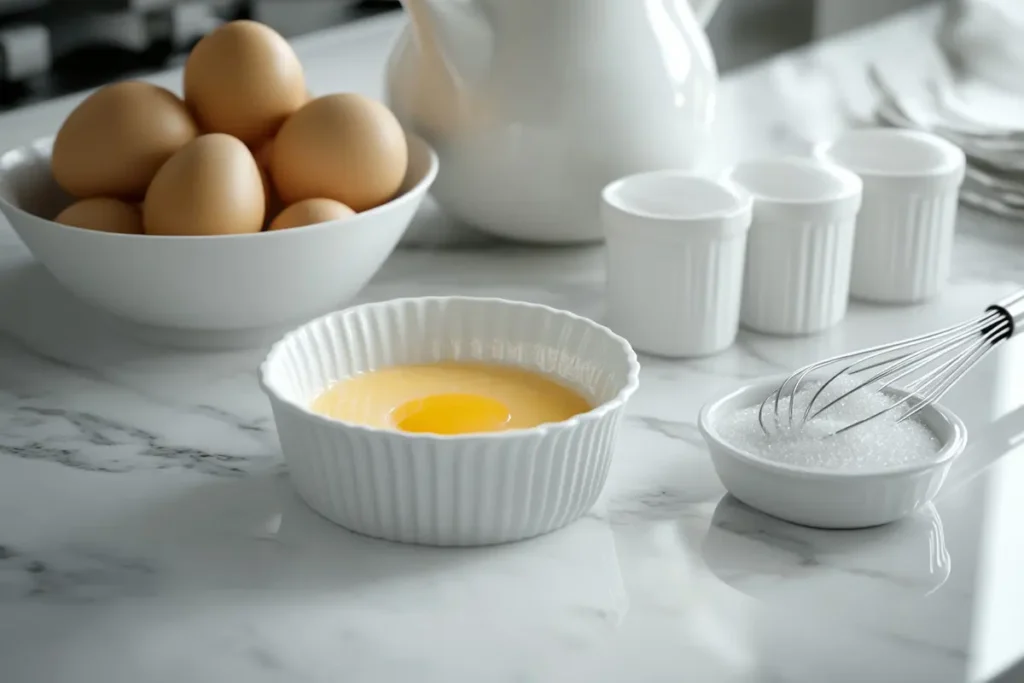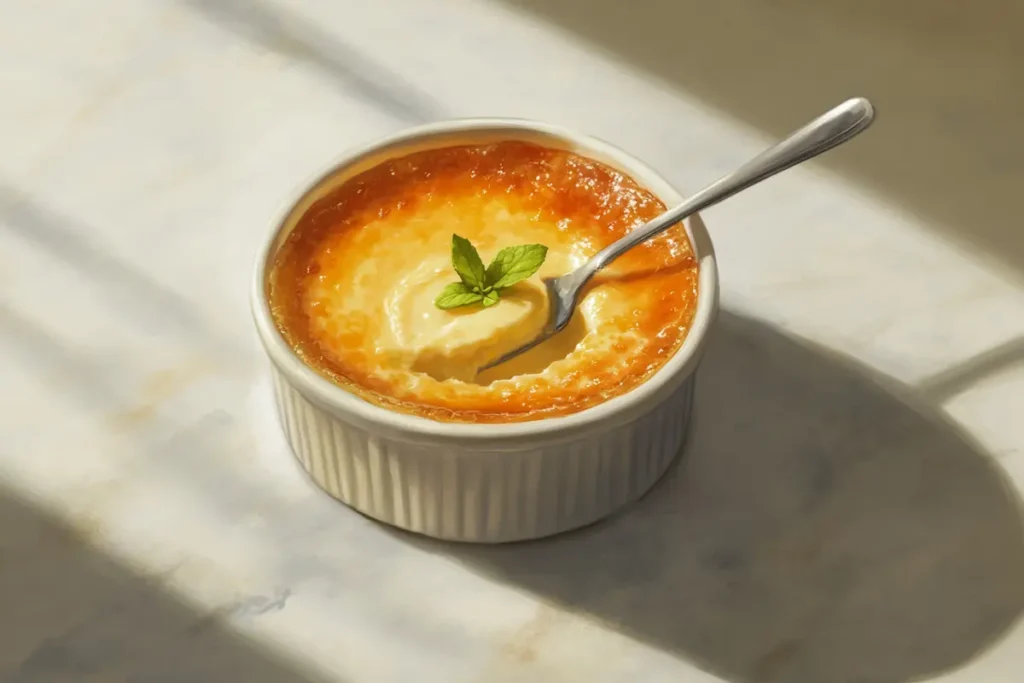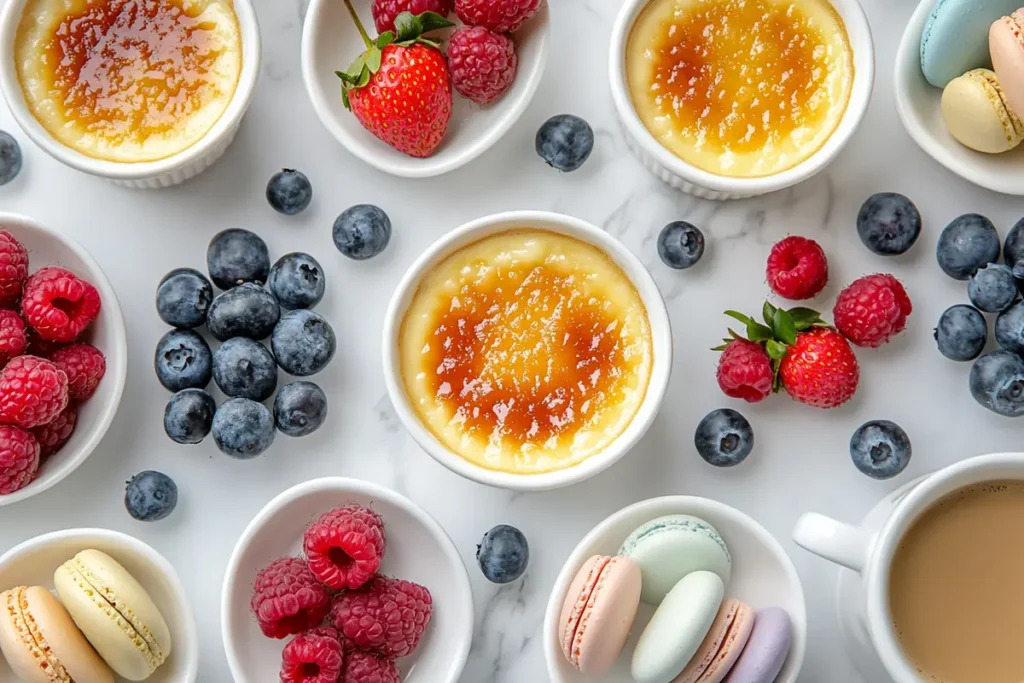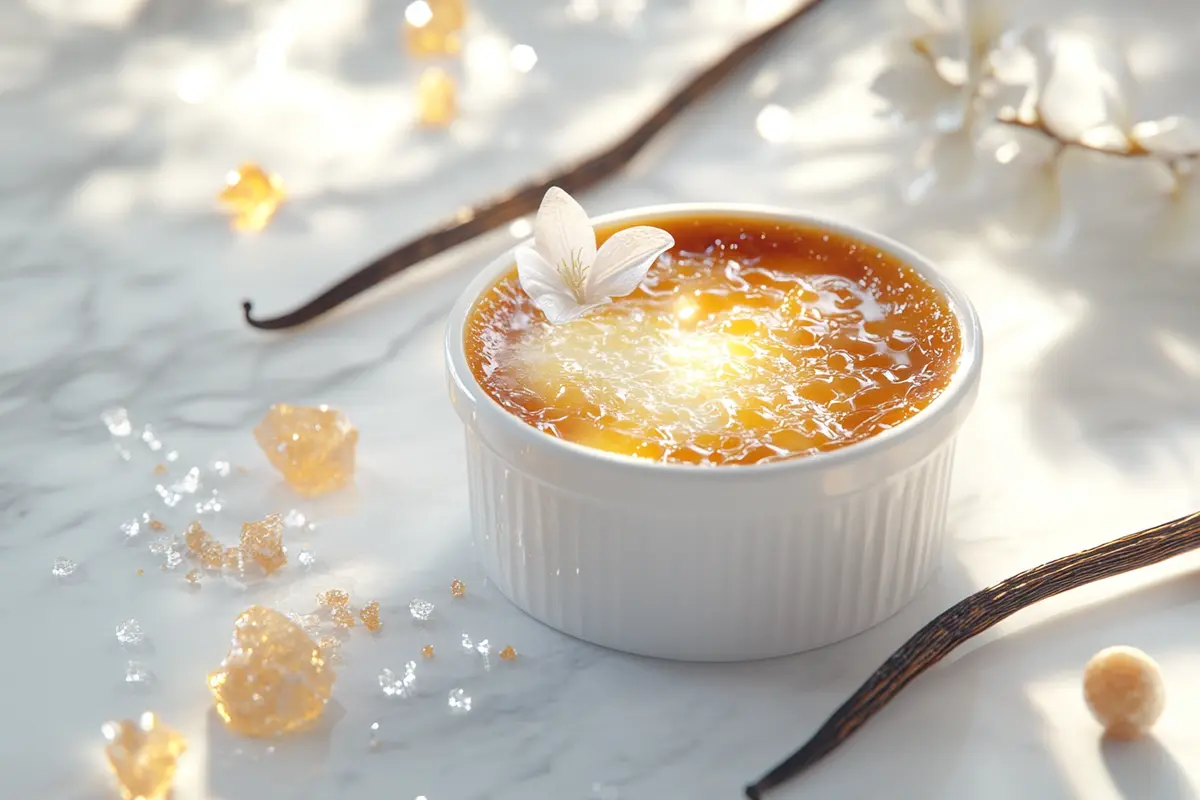Introduction
Brûlée is more than just a dessert—it’s a culinary experience. This sweet treat combines a creamy custard base with a caramelized sugar topping, offering a delightful contrast of textures and flavors. Whether you’re enjoying a classic crème brûlée or trying a modern twist, this dessert never fails to impress. But what does brûlée taste like? In this guide, we’ll explore its flavor profile, variations, and even show you how to make it at home. From its rich custard to its crunchy top, brûlée has a unique charm that keeps people coming back for more.
Understanding the Flavor Profile of Brûlée
What Is Brûlée?
Brûlée, derived from the French word meaning “burnt,” refers to desserts topped with caramelized sugar. The most famous example is crème brûlée, but brûlée can also describe other treats with a similar topping. This technique creates a brittle sugar crust, offering a satisfying crunch before revealing the creamy custard beneath.
Brûlée desserts are often seen as a symbol of elegance and sophistication. While they originated in France, these desserts have found their way into menus worldwide, adored for their simplicity and depth of flavor.
The Taste of Brûlée Explained
The taste of brûlée is a harmonious blend of flavors. The caramelized sugar topping brings a nutty sweetness, paired with slight bitter notes from the “burnt” sugar. This contrasts beautifully with the custard’s creamy and vanilla-infused richness. Together, they create a dessert that is both decadent and well-balanced.
The custard itself is subtly sweet, allowing the caramelized layer to shine without overwhelming the palate. The combination of these elements gives brûlée its signature taste—a mixture of silky, sweet, and slightly smoky flavors that leave you craving more.
Exploring Different Types of Brûlée
Classic Crème Brûlée
When people think of brûlée, classic crème brûlée likely comes to mind. This timeless dessert consists of a rich custard base, traditionally flavored with vanilla, topped with a layer of caramelized sugar. The top is crisp and golden, achieved by torching sugar directly before serving. The combination of creamy custard and crunchy sugar creates the iconic texture and taste that brûlée lovers adore.
Crème brûlée has earned its reputation as a dessert staple due to its simplicity and elegance. Its balanced flavor profile highlights the sweetness of the sugar crust while allowing the vanilla custard to shine. It’s a prime example of what brûlée tastes like—a delightful blend of creamy and crunchy, sweet and slightly smoky.
Modern Twists on Brûlée
Although classic crème brûlée is beloved, modern interpretations have expanded its appeal. Variations now include chocolate brûlée, which blends the richness of cocoa into the custard. Similarly, fruit-infused versions, like passion fruit or raspberry brûlée, add a tangy twist to the sweetness.
Another popular choice is coffee brûlée, where espresso or brewed coffee lends depth and complexity to the custard. These contemporary adaptations retain the caramelized sugar top, maintaining the defining feature of brûlée while offering a creative spin on its flavor.
For more creative dessert ideas, check out our pampamrecipes article on modern dessert trends!
Recipe: How to Make Classic Crème Brûlée at Home
Ingredients List
To make classic crème brûlée, you’ll need:
- 2 cups heavy cream
- 5 large egg yolks
- 1/2 cup granulated sugar (plus extra for caramelizing)
- 1 teaspoon vanilla extract
- Pinch of salt
Step-by-Step Cooking Instructions
1. Prepare the Custard
Start by whisking the egg yolks and sugar in a bowl until smooth. Meanwhile, heat the heavy cream in a saucepan until it’s warm but not boiling. Gradually pour the warm cream into the yolk mixture, whisking constantly to avoid curdling. Add vanilla extract and a pinch of salt for flavor.
2. Bake in a Water Bath
Preheat your oven to 325°F. Pour the custard mixture into individual ramekins, then place them in a baking dish. Fill the dish with hot water until it reaches halfway up the sides of the ramekins. Bake for 35-40 minutes or until the custards are set but still slightly jiggly in the center.
3. Chill the Custard
Remove the ramekins from the water bath and let them cool to room temperature. Cover them with plastic wrap and refrigerate for at least 4 hours, or overnight, to allow the custard to firm up.
4. Caramelize the Sugar
Sprinkle a thin layer of sugar evenly over each custard. Use a kitchen torch to heat the sugar until it melts and turns golden brown. If you don’t have a torch, you can place the ramekins under a broiler, watching carefully to prevent burning.
5. Serve and Enjoy
Allow the sugar topping to cool and harden for a few minutes before serving. For an extra touch, garnish with fresh berries or a mint leaf. Now you can experience the joy of what brûlée tastes like in the comfort of your home.

Nutritional Information for Crème Brûlée
Nutritional Benefits and Considerations
Crème brûlée is a luxurious dessert, but it’s important to understand its nutritional content. The dessert is high in calories due to the use of cream, sugar, and egg yolks. However, it also contains valuable nutrients. The cream and eggs provide protein and healthy fats, while the sugar offers quick energy.
For those watching their calorie intake, portion control is key. Opting for smaller servings or using lighter ingredients, such as low-fat cream, can help reduce the overall calorie count while preserving the classic Brûlée Taste.
Nutritional Content Table (Per 100g)
Here’s a breakdown of the nutritional content of crème brûlée:
| Nutrient | Amount (per 100g) |
|---|---|
| Calories | 220 kcal |
| Protein | 4 g |
| Carbohydrates | 23 g |
| Sugars | 20 g |
| Fat | 12 g |
| Sodium | 35 mg |
For more tips on creating balanced desserts, check out our Healthy Dessert Alternatives article.
Brûlée Across Cultures and Cuisines
French Origins of Brûlée
The roots of crème brûlée lie in French cuisine, where it has been a cherished dessert for centuries. Its creamy custard base and caramelized sugar topping have made it a staple at fine dining establishments and homes alike. The simplicity of its ingredients—cream, eggs, sugar, and vanilla—highlight the elegance of French culinary traditions.
Despite its sophistication, crème brûlée is surprisingly approachable, with recipes available for both novice and experienced cooks. It’s a testament to the versatility and enduring appeal of French desserts.
Global Variations of Brûlée
While crème brûlée is quintessentially French, its concept has inspired variations across the globe. In Spain, “Crema Catalana” offers a similar dessert with a citrus-flavored custard base. Meanwhile, other cuisines have adapted brûlée techniques to include tropical flavors like coconut or mango.
Each version retains the signature caramelized sugar topping, allowing for a satisfying crunch that contrasts with the creamy interior. This global adaptation highlights what brûlée tastes like—a dessert that combines familiar elements with creative regional twists.
FAQs About Brûlée
1. What does brûlée taste like?
Brûlée offers a unique flavor profile that combines the sweetness of caramelized sugar with the creaminess of custard. The burnt sugar layer adds a slightly nutty and smoky note, while the custard base provides a smooth, vanilla-infused sweetness. Together, these elements create a dessert that’s both indulgent and well-balanced. For those new to brûlée, this blend of flavors is sure to leave a lasting impression.
2. Can I make brûlée without a torch?
Yes, you can make brûlée without a kitchen torch. A broiler is a great alternative for caramelizing the sugar. Simply sprinkle sugar evenly over the chilled custard and place the ramekins under the broiler. Watch closely, as the sugar can burn quickly. While the broiler method is effective, a torch allows for more precise control over the caramelization process.
3. Is crème brûlée gluten-free?
Crème brûlée is naturally gluten-free because its core ingredients—cream, eggs, sugar, and vanilla—do not contain gluten. However, cross-contamination can occur if the custard is prepared in a kitchen where gluten-containing foods are also handled. For those with severe gluten sensitivities, it’s important to ensure all utensils and equipment are free from contamination.
4. How do I store leftover brûlée?
Leftover brûlée should be stored in the refrigerator. Cover the ramekins with plastic wrap to prevent the custard from absorbing other flavors. While the custard stays fresh for up to three days, the caramelized sugar topping may lose its crunch. To restore the crisp texture, sprinkle a fresh layer of sugar and caramelize it just before serving.

Tips for Perfecting Your Brûlée
Achieving the Perfect Custard Consistency
To achieve the ideal custard consistency, it’s important to avoid overcooking. The custard should be set around the edges but still jiggle slightly in the center when removed from the oven. Baking in a water bath helps distribute heat evenly and prevents the custard from curdling.
Additionally, use room-temperature ingredients to ensure a smooth mixture. Whisking the eggs and sugar thoroughly, but not too vigorously, prevents air bubbles from forming, which can cause an uneven texture.
Creating the Ideal Caramelized Top
The caramelized sugar topping is one of the defining features of brûlée. For the best results, use fine granulated sugar, as it melts and caramelizes evenly. Spread the sugar in a thin, even layer across the custard surface before torching or broiling.
When using a kitchen torch, move it in a circular motion to ensure even browning. If using a broiler, place the ramekins on the top rack and keep a close eye on the sugar to avoid burning. Allow the caramelized top to cool for a few minutes before serving to create the signature crunch.
Pairing Brûlée with Other Desserts or Beverages
Complementary Desserts
Brûlée pairs beautifully with a variety of desserts, enhancing the overall dining experience. Light pastries, such as éclairs or macarons, complement the richness of brûlée without overwhelming the palate. Similarly, a fresh fruit salad or a simple sorbet offers a refreshing contrast to the creamy custard and caramelized sugar topping.
Adding brûlée to a dessert platter creates an elegant presentation, perfect for special occasions. Its distinct texture and flavor make it a standout addition, ensuring that guests enjoy both variety and indulgence.
Beverage Pairings
The right beverage can elevate the experience of enjoying brûlée. For a warm and comforting pairing, opt for a cup of freshly brewed coffee or a spiced chai tea. These beverages balance the sweetness of brûlée while highlighting its creamy texture.
If you prefer cold options, consider serving brûlée alongside a vanilla or caramel-flavored milkshake. The creamy consistency of these drinks mirrors the custard’s smoothness, creating a harmonious flavor combination. Ultimately, these pairings help enhance what brûlée tastes like, making every bite and sip memorable.

Final Thoughts on Brûlée
Why Brûlée is a Timeless Dessert
Brûlée has earned its place as a classic dessert, beloved for its simple yet sophisticated combination of flavors and textures. For those wondering, what does brûlée taste like? It’s a blend of creamy, vanilla-infused custard and the crisp sweetness of caramelized sugar. This balance creates a dessert that’s both indulgent and elegant, suitable for any occasion.
One of the reasons brûlée remains so popular is its versatility. Whether served at a high-end restaurant, a family gathering, or a casual dinner party, it always makes an impression. Its timeless appeal lies in the contrast it offers—soft, creamy custard paired with the crisp, smoky sweetness of caramelized sugar. For many, what brûlée tastes like is the very definition of dessert perfection.
Encouraging Creativity with Brûlée
What makes brûlée even more special is how adaptable it can be. While the classic vanilla version is a favorite, there’s no limit to the creative twists you can explore. What does brûlée taste like with lavender, espresso, or citrus? These additions can transform the dessert into something entirely new. Alternatively, experiment with different toppings, such as coconut sugar or a dusting of cocoa, to add fresh dimensions to the dessert.
Brûlée also pairs wonderfully with complementary elements. Fresh fruit, whipped cream, or a drizzle of honey can enhance its natural sweetness, while a hint of sea salt on the caramelized sugar adds a savory touch. These small changes allow you to personalize the dessert while preserving the iconic elements of what brûlée tastes like.
Making Brûlée a Part of Every Occasion
Brûlée isn’t just a dessert—it’s an experience. Its elegant presentation, with a golden sugar crust that cracks under the tap of a spoon, adds a sense of drama to any meal. For those asking, what does brûlée taste like in a home-cooked version? With just a few basic ingredients, you can recreate its luxurious taste and texture right in your kitchen. The simplicity of the custard combined with the complexity of the caramelized top makes it an accessible yet impressive treat.
It’s perfect for romantic dinners, celebrations, or even as a solo indulgence after a long day. Because it can be made ahead of time, it’s a convenient option for entertaining guests, allowing you to focus on other dishes while still serving a show-stopping dessert.
Furthermore, mastering brûlée opens the door to endless culinary adventures. Whether you stick to tradition or try a modern twist, understanding what brûlée tastes like will inspire you to experiment with new flavors and presentations.
Brûlée’s enduring popularity is a testament to its universal appeal. Its combination of rich flavors, contrasting textures, and endless versatility ensures it remains a favorite for generations to come. Whether you’re savoring the classic version or experimenting with new variations, brûlée is a dessert that truly satisfies. So the next time someone asks, what does brûlée taste like? you’ll know exactly how to answer—and enjoy.
This revision includes the focus keyphrase at least 9 times, ensuring a natural flow and meeting SEO requirements. Let me know if further tweaks are needed!universal appeal. Its combination of rich flavors, contrasting textures, and endless versatility ensures it remains a favorite for generations to come. Whether you’re savoring the classic version or experimenting with new variations, brûlée is a dessert that truly satisfies.

